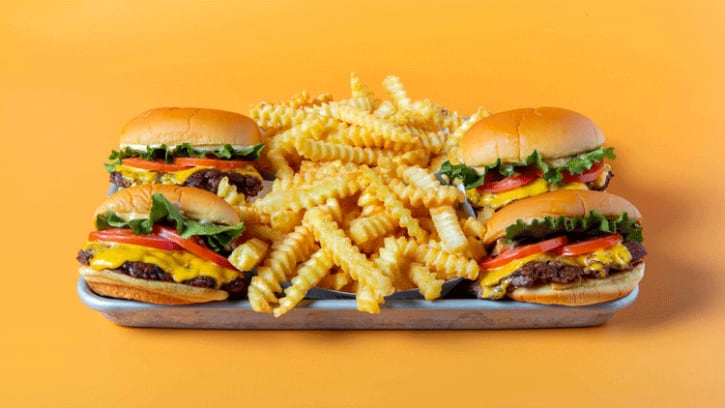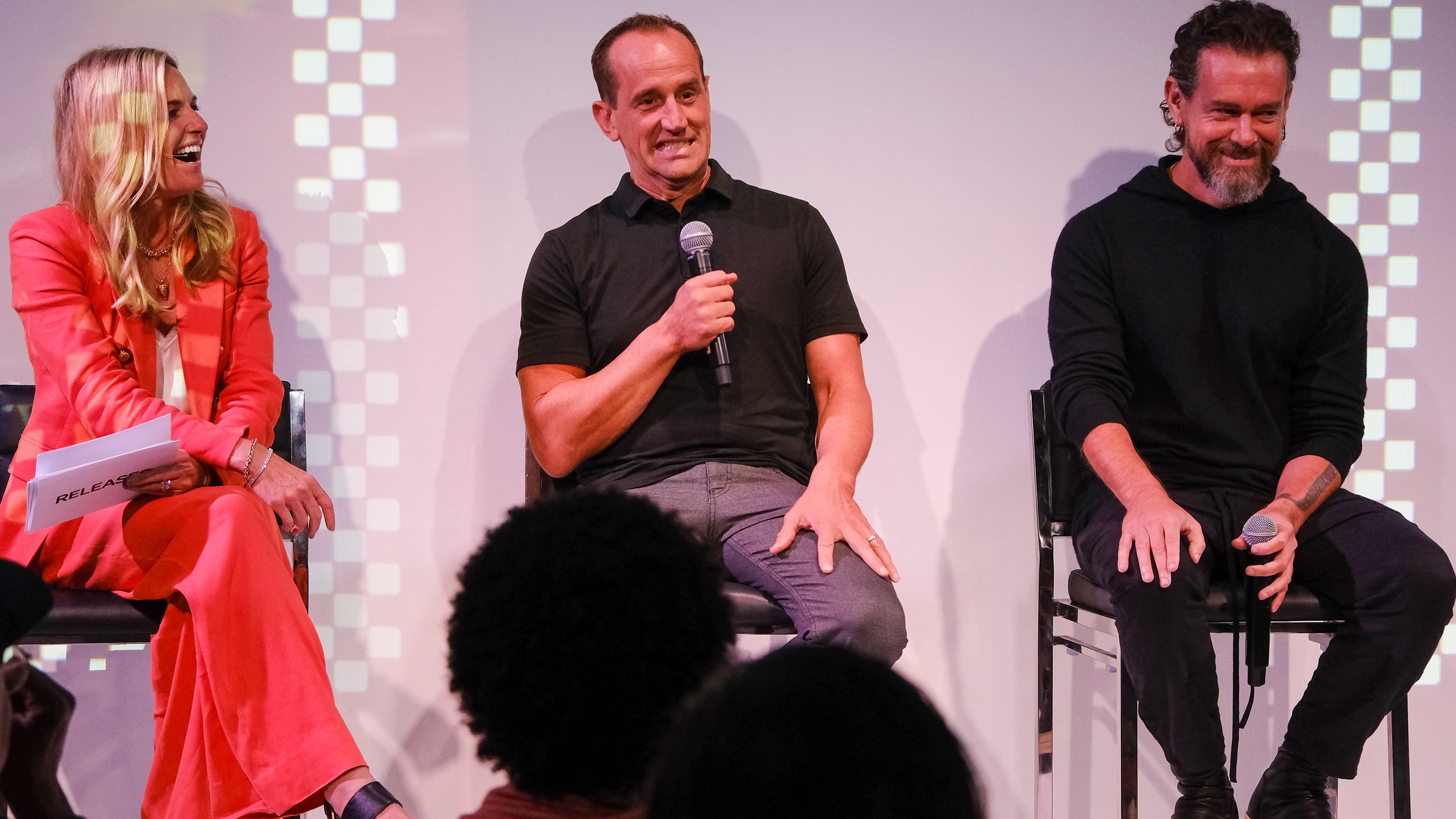Earlier this month, Restaurant attended payment and POS company Square’s Releases event in New York. The main attraction was a fireside chat between Square founder Jack Dorsey, a titan of the technology world having also co-founded Twitter, and former Shake Shack CEO Randy Garutti who played a pivotal role in turning a hot dog cart in Manhattan’s Madison Square Park into a global restaurant business.
Hosted by Square chief marketing officer Lindsey Irvine, the wide-ranging discussion gave a fascinating insight into the early days of both brands and what it takes to lead a disruptive company. Both spoke candidly about failure, the importance of staying curious and the moments that tested their conviction. Looking ahead, Dorsey and Garutti also explored how AI and automation are set to change their respective industries.
You both had big, bold, disruptive visions when you started out. Tell us about the early days of your respective businesses
Randy Garutti: I won’t bore you with the whole story. But we started out as a fine dining company (Union Square Hospitality) opening one restaurant at a time, including Union Square Café, Gramercy Tavern and The Modern. One day we put out a hot dog cart to raise money for an art project. Fifty people lined up, then a hundred people lined up, and we ended up running the hot dog cart for three years. Nobody wanted to deal with it. It was a pain in the ass. We were busy running fine dining restaurants. It turned into a little burger joint (moving into a permanent kiosk in Madison Square Park). But it wasn’t for nearly seven years after the hot dog cart that we opened our second location. We never sat there and said, “let’s have 500 restaurants” or “let’s have an IPO”, and I think that’s exactly why those things happened. We surrounded ourselves with the most high-energy, fun, naïve group of leaders who just wanted to kick ass doing one great thing. It was truly organic. If I had known everything I know today and you put me back in that job 25 years ago, I would have messed it up.
Jack Dorsey: Our vision wasn’t actually that large when we started. For most entrepreneurs, it’s just so hard beginning. The crystallising moment for us was that we were building this credit card reader. It felt magical because you could plug it into your phone. It was also cool that we were listening to the little audio track on the back of a credit card. Nobody really knew about that. We figured out a way to hack it and built some software. We then tried to sell the device to the merchants around my apartment. It took us a little bit of time to realise that nobody wanted to accept credit cards. But the world was moving to a place where more and more of their customers were using plastic because it was more convenient. So, the sellers didn’t want to accept credit cards, but they didn’t want to miss the sale. If we didn’t have that insight and go a little bit deeper into the ‘why’ behind what we were making, we would have been a very small company and I wouldn’t be here talking to you. Understanding that it was about helping the seller make the sale allowed us to look at lending money to sellers to help them build their businesses, and also things like customer relationship management and staff management.
Was there a time for either of you where people said ‘this won’t work’?
RG: So many times. And it was probably mostly us saying that to ourselves. We ask one question every day as entrepreneurs: “who wrote the rule it’s got to work this way?” We didn’t invent the cheeseburger, we did zero unique things. But we took every little bit of what traditional fast food had destroyed over a 50-year period and said, ‘what if we just do that one little thing a little bit better?’ Every day, my mantra with the team in the restaurants was, ‘today, we need to do what everyone else is unwilling and unable to do’. There’s no way any smart financial person would have signed off on what we did in the early days of the company.

JD: When we started the company, Visa told us it would never work, and we weren’t allowed to use their network. That was pretty scary, because that was our whole business model. We had a significant dependency on that person saying yes, and they said no for nine months until we could prove it out. Then we had this board of all these old-head financial folks from places like Goldman Sachs. They said loans would never work and that we should never be in that business. It took us six months to convince them that it would work. As a leader of a company, you have to be okay with losing credibility, because in each one of those moments everyone in the company thought that I was a blockhead, which is why I made my role ‘blockhead’.
You are both passionate about customer experience and also the power of design to transform the customer experience. What are your guiding principles?
JD: The only one is to give our customers time back. If you focus on those three words, it puts everything in motion. We have to build something that is so intuitive that as soon as you look at it you understand exactly how it works. It’s why we named the business Square in the first place - we didn’t want something that was in front of our customers; we wanted a name that was boring and plain. It was very deliberate, and it set the tone for the company. Now we have all this AI and automation, we can just go crazy and give so much time back.
RG: Great restaurants are of their place. Take Katz’s Deli (the world-famous New York deli and restaurant). It is singular. There is nowhere else in the world you can be than at Katz’s Deli when you’re at Katz’s Deli. When a restaurant becomes essential to its neighbourhood, you’ve won. And that starts with the design.
JD: Our first company name was Squirrel, and we were going to make the reader in the shape of an acorn. This was very challenging from a design perspective. So, when we looked in the dictionary for the word ‘square’ we were like, this is perfect - the hardware is going to be simple now.
What failure did you learn the most from?
RG: We got a one-star review in The New York Times (which is great for a burger joint), but they didn’t like the French fries. So, we set out to create the best French fry anyone had ever had. We spent millions of dollars shipping potatoes around the world, soaking them three times, frying them twice. We created the single greatest fresh-cut fry you’ve ever had in your life. We launched them - and everybody fucking hated them, including my kids. The lesson was: don’t let a few loud voices tell you what to do in your business. That screw-up ended up working out really well for us because it happened a year before we went public. If you ever do an IPO, try and do something really bad a year before it.
JD: My favourite is that when we started the company, we finally got Visa to say yes, but they only said yes to a thousand merchants - and we accidentally put an extra zero on the 1,000-merchant cap in the code. They called us one day and said it looked like we were processing a lot more than they expected and that it was more like 10,000. We were like, ‘oops’. We asked if they wanted us to turn off the 9,000 merchants and they said, ‘no - and you can add another zero to it as well’. That’s when we knew we were solid.
How will AI change restaurant technology?
JD: The biggest challenge is knowing what question to ask. A lot of people don’t want to do that work - and you don’t know what you don’t know. Fortunately, we have a very great understanding of our sellers’ businesses, and we can make our systems a lot more proactive. It will be like hiring a manager to sit alongside you and be proactive, making suggestions that are rooted in real data - your data. It will feel very organic and human. That is the thread we are pulling on.
Randy, what have you been doing since you retired from Shake Shack?
RG: I’m not comfortable with the word ‘retired’ yet. I’m not missing a single soccer or basketball game with my kids, because I missed a lot. That’s the number one focus. But professionally, I’m spending a lot of time with young entrepreneurs. I’m learning and supporting them and trying to share a lot of the mistakes that we made and some of the things that we got right.


